Skinny pigs have taken the pet world by storm as people either admired them or criticized their appearance and origin. These hairless creatures will have anyone taking a second look at their peculiar appearance. The same hairless state that causes them to be different also puts them in a place where they are in need of special care.
Skinny pig is a hairless type of guinea pig breed but they are not completely hairless. They were developed in a laboratory after scientists found a spontaneous genetic mutation while crossbreeding guinea pigs. This genetic mutation in the form of a recessive gene causes their lack of fur.
Table of Content
Hairless Skinny Pig | Everything You Need to Know!
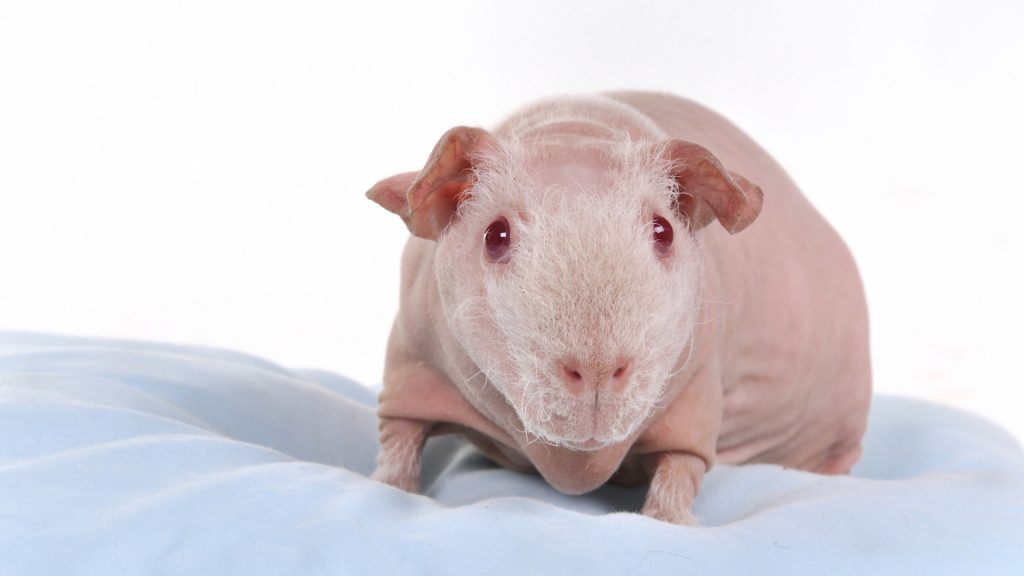
Are Skinny Guinea Pigs Completely Hairless?
Despite their hairless characteristic, Skinny pigs are not completely hairless because they have a bit of hair on their muzzles, legs, and feet. However, they remain hairless on other parts of their bodies.
Are Skinny Pigs Born With Hair and Why Are They Hairless?
Skinny pigs are born almost hairless. Their hairless state is the result of lab experiments that were carried out in 1978 for dermatology studies. In fact, they were initially bred for laboratory use and have only recently made their way into the pet world. A recessive hairless mutation causes them to be almost completely bald.
How Long Do Skinny Guinea Pigs Live?
Guinea pigs, in general, have the longest lifespan when it comes to rodents. Some Skinny pigs have been reported to live up to ten years but these are really rare cases. The average lifespan for Skinny guinea pigs is around 6 to 8 years.
How long a guinea pig is going to live also depends on the owner. Special care needs to be taken to prolong their life and we are going to talk about that in more detail later in the article.
How Big Do Skinny Guinea Pigs Get?
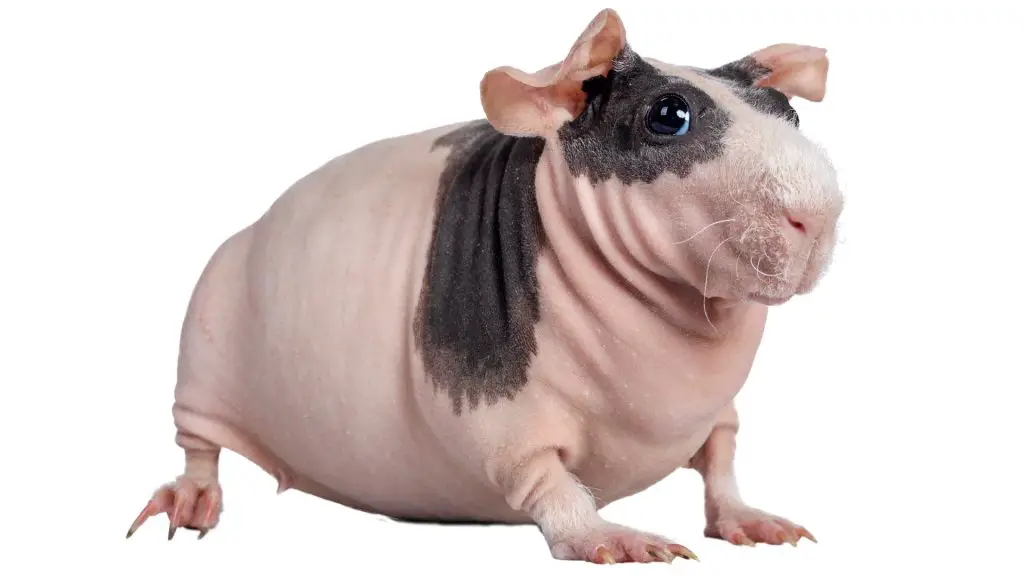
At birth, a Skinny pig is around 3 to 4 inches long. However, they grow really fast and will almost double in size at only two months of age. Their growth rate then reduces and they reach adulthood around 6 months.
Adult Skinny pigs are around 9 to 10 inches in size. Their size and lifespan depend on numerous factors and it is really hard to pinpoint how big a certain Skinny pig is going to get.
Can Skinny Guinea Pigs Cause Allergy?
Skinny guinea pigs can’t cause allergies that are related to fur (hair). If your allergies are due to the fur, then a Skinny pig might work well for you. But before purchasing one, try spending some time with a Skinny pig because the main cause of allergic reactions from guinea pigs to humans is in fact their saliva, urine, and dead skin cells otherwise known as dander.
Skinny Guinea Pig Colors and Patterns
Skinny guinea pigs come in many colors, which include silver, black, white, golden, chocolate, grey, pink, and many more. Some of them are patterned just like their hairy cousins. These are some of the most common patterns for Skinny pigs:
- Dutch-patterned Skinny pigs have a marked face and muzzle, a white neck, chest, belly as well as white front paws.
- Himalayan Skinny pigs have white/pinkish bodies, with colored faces, ears, and feet. Their overall color is actually like that of a regular pig.
- Tortoiseshell Skinny pigs have significant patches around the neck and hind. These patches are usually pink, brown, and black.
Skinny Pig Names That People Use
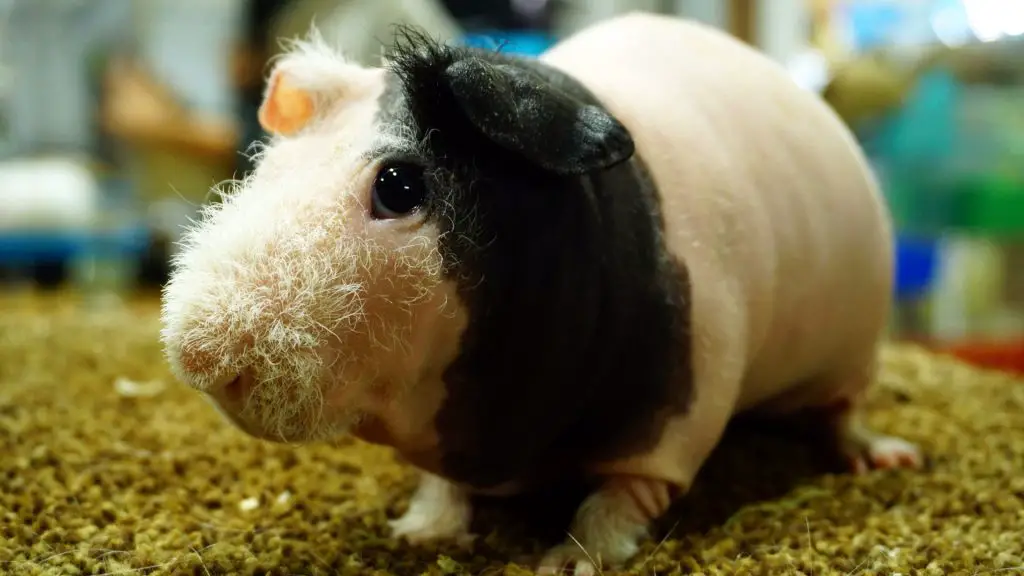
There are different names that people use to call their Skinny pigs. Before we get to them, let’s look at why this unique breed is called a Skinny guinea pig.
Skinny guinea pigs are called that way because their lack of fur makes them look “skinnier” when compared with guinea pigs that have thick fur. Saggy and exposed skin also plays a part in the name. Now let’s talk about other names that people use for them.
- Skinny pig hippo/House hippo – Skinny pigs actually got this name from their appearance. They look very much like baby hippos. The only difference is their droopy ears and furry muzzles. Other than that, having a smooth cylinder-like body, thick neck, square-like face, and naked skin, the name “Hippo guinea pig” simply writes itself.
- Werewolf Skinny pig – Werewolf Skinny guinea pigs have a little bit more hair on their body than “regular” Skinny pigs. This hair is typically located around the face, neck, and shoulders and it can at times extend to the rump. They are still classified as Skinny pigs and their looks resemble somewhat of a werewolf.
Skinny Pig Care Guide | Instructions and Tips
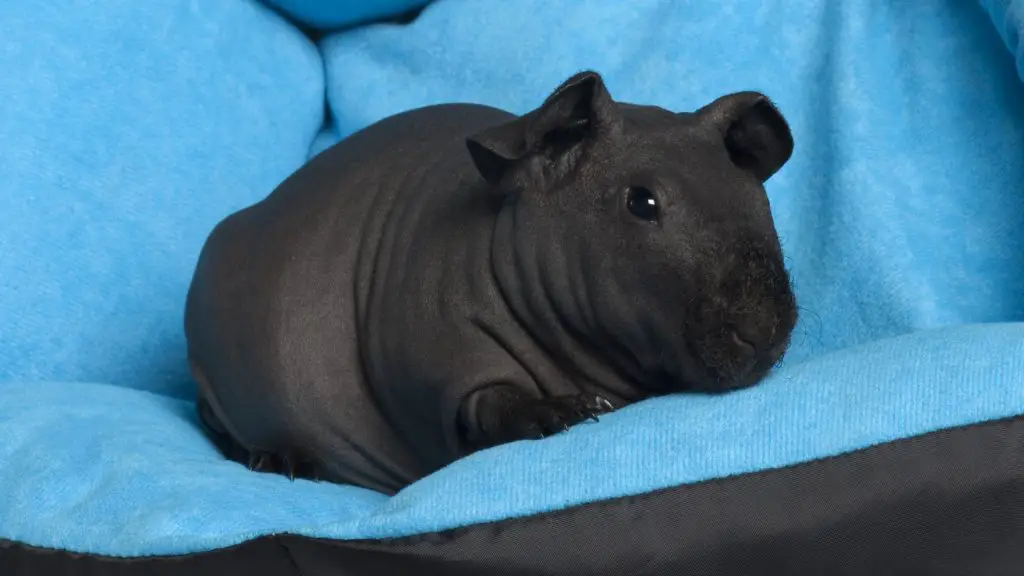
Skinny pigs require just a little bit more attention than guinea pigs with hair. Their exposed skin is the biggest factor here because their lack of fur means that they are essentially unprotected. Also, care for baby Skinny guinea pigs isn’t that much different from regular guinea pig baby care.
The major difference remains their lack of protective fur but this is exactly where the role of the owner comes into play. In the following sections, you will find some tips and instructions on how to care for Skinny pigs. Let’s start!
Skinny Pig Skincare and Health
To keep Skinny guinea pigs healthy, avoid bathing them often because that way you will remove the protective oil layer on their bodies. Instead, opt for cleaning your Skinny pig with a damp towel but even then try not to give them baths very often.
Skinny pigs should be kept indoors where temperatures are optimal for them (not too warm or cold). In case the temperature outside allows for a guinea pig day out, then you may need to use some pet-safe sunscreen on their delicate skin. Even then, try keeping them out of the direct sunlight.
Skinny Pig Cage Requirements
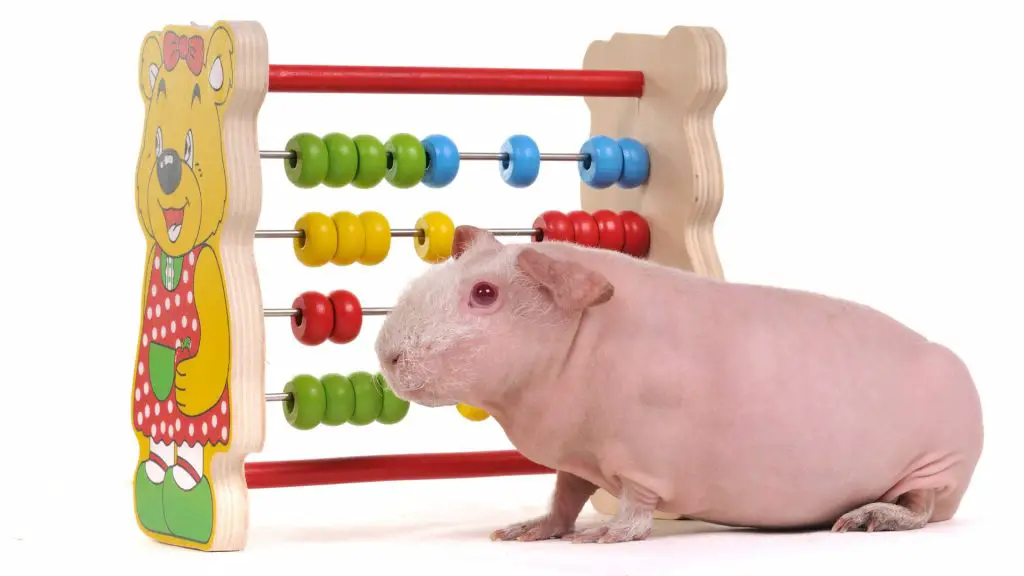
Size of the Cage and Position
While picking out a cage for your Skinny Pig, you need to think about its delicate anatomy. First, select a large space in which to place their cage because your Skinny pig needs space to play around and run.
While at it, avoid direct cold air drafts coming into contact with your cavy because Skinny guinea pigs are prone to upper respiratory infections, which can progress to pneumonia. This is also why their cage needs to be placed away from direct drafts and sunlight.
Material of the Cage
After deciding on the space, it’s time to choose the material of the cage. The cage material needs to be either plastic or stainless steel wire. Also, ensure that the floor is covered using a cage mat to avoid your cavy getting bumble feet. Have a safety latch to protect your cavy from outside forces, including your other pets.
Toys and Accessories
Remember that your Skinny guinea pigs will be spending most, if not all, of their time in the cage. This is why it is important to also buy them some play accessories like hideouts (tunnels). Toys, such as chew toys, blocks, ramps, etc., will keep your Skinny guinea pig busy when it isn’t eating or sleeping.
Skinny Pig Diet
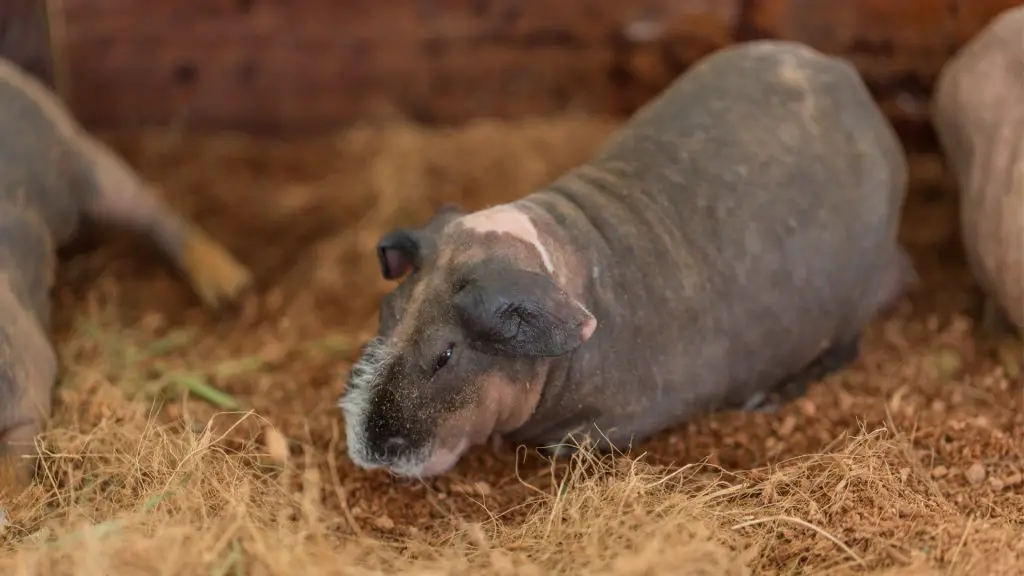
Skinny guinea pigs can in some cases eat more than their hairy cousins because their bodies work extra hard to keep themselves warm. To ensure that your cavy is getting a balanced diet suitable for their growth and overall health, try following these diet tips:
- Vitamin C is mandatory. In order to regulate the vitamin C intake of Skinny guinea pigs, you can opt to use pellets rich in vitamin C or give them vegetables and fruits that are high in the vitamin.
- Hay should always be available for the Skinny pig. Use the Timothy, or Orchard hay, or when they are younger, the Alfalfa hay. A fresh batch should be provided daily. However, Alfalfa hay is only good for young pups and pregnant or even nursing cavies because it is rich in calcium. For adult guinea pigs, high amounts of calcium are not good and can cause serious health problems.
- Adding some fresh grass to their diet brings variety and is certainly good for your pet. Try introducing fresh fescue and bluegrass, which will certainly add to your cavy’s amount of vitamin c, minerals, and nutrients.
- Pellets are also a must for guinea pigs and should be given to them on a daily basis. Check for freshness before purchasing them. Remember to ensure that it should be stored properly because vitamin C tends to lose its effectiveness with time.
- There should always be enough water for your Skinny pig available 24/7. We recommend buying a water bottle and attaching it to the side of the cage. Water bottles are a simply better solution when compared to bowls.
- Incorporate vegetables (leafy greens) and fruits into the diet of your Skinny guinea pig.
Skinny Guinea Pig Clothes | Do They Really Need Clothes?
Dressing up Skinny guinea pigs is not wise because it won’t feel natural for them and they may even try getting out of the clothes. In case they are stuck in clothes, they might get stressed up.
One of the ways to keep your Skinny cavy warm is fleece bedding. Also, the cage should be placed in a warm corner of the house, away from a cold draft. There are pictures of dressed-up Skinny guinea pigs which are obviously adorable but clothes can also cause them skin irritations. Clothes for any pet or animal need to be avoided.
Skinny Pig vs. Baldwin Guinea Pig | Main Differences
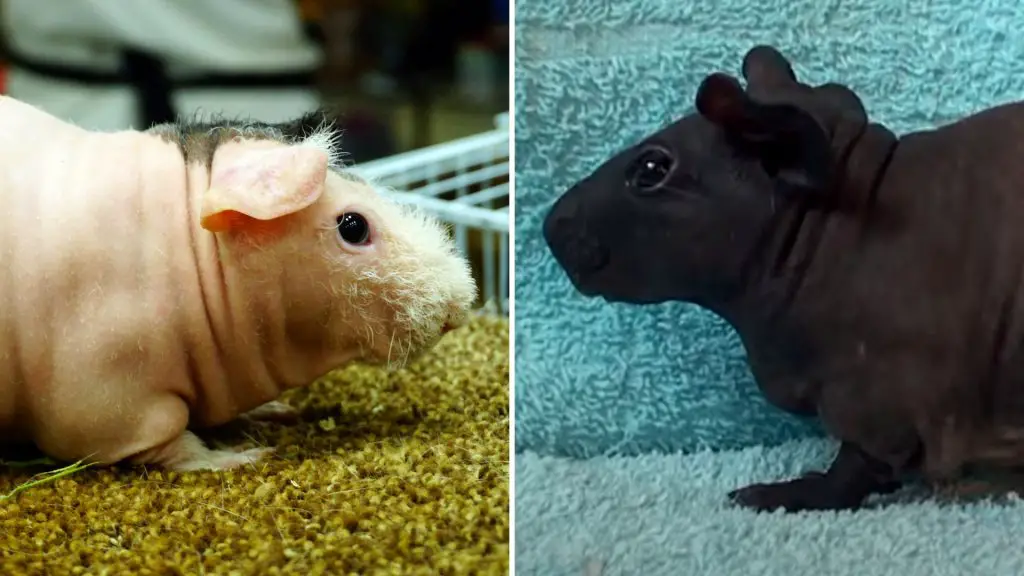
There are two types of hairless guinea pigs called Skinny pig and Baldwin guinea pig.
The main difference between a Skinny guinea pig and a Baldwin guinea pig is the fact that Skinny pigs have some fur on their forehead and legs, while a Baldwin pig is completely bald.
Also, a Baldwin guinea pig is born completely covered in fur and it gradually becomes bald while Skinny guinea pigs are born without fur.
Finally, the factor that also causes their differences is their origin. While the Skinny pig was a result of a lab experiment in the late ’70s, the Baldwin guinea pig was a result of the spontaneous breeding of white-crested Guinea pigs.
How Much Do Skinny Pigs Cost?
The price of a Skinny guinea pig varies per breeder and is also affected by whether you are buying an adult or a baby. However, the average price starts from around $50 and goes all the way up to $200.
These prices are higher than those of guinea pigs with fur because of the extra care that Skinny cavies require compared to their hairy relatives. Also, they are a much rarer bread than the ounces with fur.
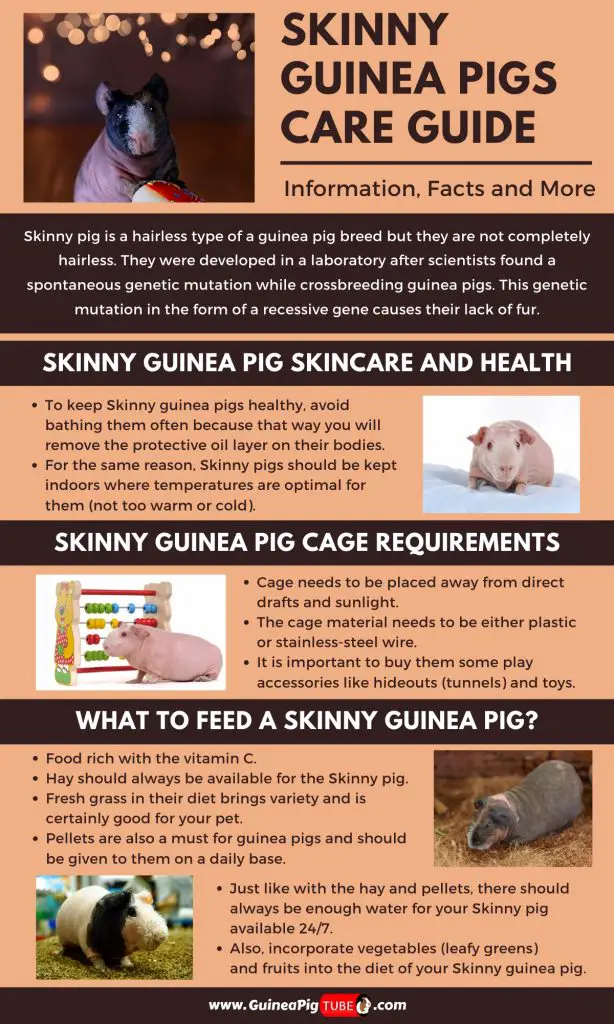
Regardless of their challenging past, Skinny pigs have certainly found their place in the world of pets. They are quite social and should fit in well with any family. People that have fur allergies are certainly going to like these amazing pets. If you are looking for a caring and special pet then Skinny pigs are perfect for you!
List of Sources
Temperature Preference in IAF Hairless and Hartley Guinea Pigs (Cavia Porcellus)
Karyotype of Hairless Guinea Pig
Development of Hairless Laboratory Guinea Pigs: The Biological Studies
Hairless Pigmented Guinea Pigs: A New Model for the Study of Mammalian Pigmentation
Hairless Guinea Pig Skin: Anatomical Basis for Studies of Cutaneous Biology
